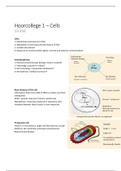Hoorcollege 1 – Cells
3-9-2018
Cells:
1. Membrane-enclosed unit of life
2. Metabolism (most characteristic feature of life)
3. Growth and division
4. Response to environmental signals, internal and external communication.
Interdisciplinary:
1. Biochemistry/molecular biology: factors involved?
2. Physiology: purpose or reason?
3. Bio technology: manipulate metabolism?
4. Biomedicine: modify/counteract?
Basic features of the cell:
Information flows from DNA to RNA to protein and then
metabolites
(DNA – genetic material, Proteins: workhorses
Metabolites: molecules produced or altered by cell)
Interplay between these factors is very important.
Prokaryotic cell.
Small (1-5 micrometre), single cell (like bacteria, except
biofilms). No membrane-enclosed compartments.
Biochemically flexible.
,Eukaryotic cell.
Much more complex and much larger (20-50
micrometre), many multi-cellular but it doesn’t need
to be) and membrane enclosed compartments.
Compartments:
1. Nucleus: DNA synthesis and transcription. The diameter is 5-10 micrometre, surrounded by a
double phosphorlipid membrane with nuclear pores: make exchange/transport possible (bv RNA
from inside to outside and transcription
factors from outside to inside the nucleus).
The nucleus membrane does not look like a
normal membrane because it is not
continuous, it is interrupted by nuclear pores.
We can see the nucleus with an optical
microscope. The nuclear pores must be big
enough in diameter so that proteins (e.g.
transcription factors) can enter the nucleus.
2. Endoplasmatic reticulum: protein modification
(foldings, glycosidation) and transport/sorting.
Closely connected to protein synthesis. Membrane
proteins are inserted in the ER. Station for secreted
proteins.
3. Golgi: membrane system. Further modification of proteins
(in particular glycolysation), sorting, transport. Vesicles fuse.
Transport, to from and within golgi by transport vesicles (200-
300 nm). Cis- and trans- side.
,4. Mitochondria: energy metabolism, fatty
acid oxidation. They have a double
membrane. Mitochondria produce ATP and
citric acid cycle (key cycle of metabolism):
the main function is to produce NADH.
When apoptosis: the mitochondria take over
what the cell needs to do. Vetzuur synthese
in cytosol en oxidatie/afbraak in
mitochondrion, dit is dus
gecompartimenteerd omdat er anders
kortsluiting ontstaat. When fatty acid is
oxidized in mitochondria, acetyl-CoA is produced, which enters
the citric acid cycle, and NADH and FADH2, which are co-enzymes
used in the electron transport chain.
1. Breakdown acetyl-CoA → FADH2, NADH, GTP and amino acids
(biosynthesis).
Size of mitochondria is 0,5 - 1 micrometre in diameter.
5. Lysosome: hydrolytic enzymes to break down non-needed
proteins: degradation processes (proteins, nucleic acids,
carbohydrates). There is a low pH for the degradation processes.
They fuse with phagosome (vesicle with material taken up) or old
organelles. Size of a lysosome is 50-500 nanometre.
6. Transport vesicles: transport between compartments. Crucial for distribution of material and
information. Size of a transport vesicles is 100 nanometres or a couple of 100 nanometres. Key
transport means in eukaryotic cell. Closely related to ER/golgi.
, 7. Cytoskeleton: Structuring the cell. Cell movement
Transport within the Cell. Microtubuli 20 nm (thick) Actin
(spieren) 5 nm (thin) and Keratine in between in size.
8. Chloroplast: in photosynthetic organisms. Capture
energy from sunlight. They produce ATP. Size: 0,5 micro
metre.
9. Cytosol: water-based gel. Not just a space where things can move freely.
Concentration of proteins is very high in the cytosol. Compartment with a special
structure. The cytosol is crowded with a broad range of molecules. Many chemical
reactions central in metabolism. Veel reacties hierdoor.





